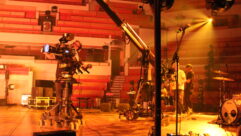Video shot by Joshua Ballinger, edited and produced by Jing Niu and David Minick. Click here for transcript.
As Apollo 13 astronaut Fred Haise floated in the tunnel snaking between the Lunar Module and Command Module, he heard—and felt—a loud bang. Around him, the two vehicles began to contort. Then, the metal walls of the tunnel crinkled as the spacecraft shuddered.
Wide-eyed, Haise scrambled from the tunnel into the Command Module alongside Jack Swigert and their commander, Jim Lovell. From his customary position at Lovell’s right, Haise quickly assessed something was drastically wrong with the spacecraft’s cryogenic tanks—the oxygen was just gone. Fortunately, there didn’t seem to have been a chemical explosion, because only a thin wall separated the oxygen tank from the propellant tanks used to power the spacecraft’s main engine.
“It really didn’t explode like something you think of with shrapnel,” Haise told Ars, in an interview. “It just over-pressurized, and then it let go some steam. If it had been a shrapnel-type explosion, I wouldn’t be here today.”
The incident took place April 13, 1970, near the end of the second full day of the Apollo 13 flight. The crew aboard NASA’s third mission to the surface of the Moon had just completed a live television broadcast. They were tired but also excited. They were supposed to go to bed soon, and when they woke up, the spacecraft would enter lunar orbit. Within about a day, Lovell and Haise were set to become just the fifth and sixth humans to walk on the surface of another world. MORE@ArsTechnica
WHY THIS MATTERS: It’s a more forensic account complete with some drawings/diagrams, historical photos of people and control panels, computer printouts. Just a rich must-read. -Cynthia Wisehart










